Fantasy Art Magazine, the leading professional magazine in China for the imaginative arts, has just published a 10-page portfolio of Dinotopia artwork.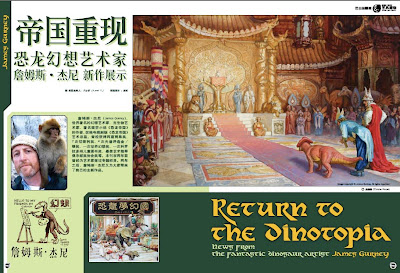 The recent book Journey to Chandara, features some of China's exciting dinosaur discoveries, such as the Microraptor from the Liaoning province, and great discoveries from the Gobi desert, such as Protoceratops and Oviraptor. The interior of of Chandara's Imperial Palace was based on the historic photographs of temple interiors by John Thomson. (1837-1921)
The recent book Journey to Chandara, features some of China's exciting dinosaur discoveries, such as the Microraptor from the Liaoning province, and great discoveries from the Gobi desert, such as Protoceratops and Oviraptor. The interior of of Chandara's Imperial Palace was based on the historic photographs of temple interiors by John Thomson. (1837-1921)
Dinotopia books have been released in China in three different translated editions. Happy New Year (Year of the Tiger, Feb. 14) to my friends at Fantasy Art Magazine.
Viewing: Blog Posts Tagged with: Journey to Chandara, Most Recent at Top [Help]
Results 26 - 40 of 40
Blog: Gurney Journey (Login to Add to MyJacketFlap)
JacketFlap tags: Dinotopia, Journey to Chandara, Add a tag
Blog: Gurney Journey (Login to Add to MyJacketFlap)
JacketFlap tags: Journey to Chandara, Add a tag
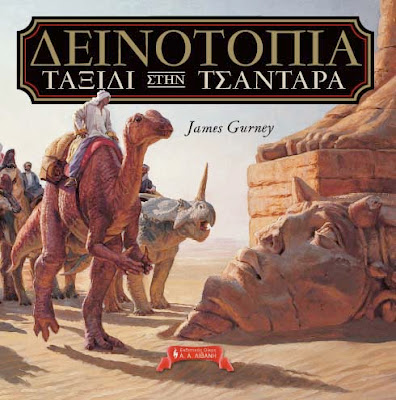 The Greek edition of Dinotopia: Journey to Chandara has just been published.
The Greek edition of Dinotopia: Journey to Chandara has just been published.
Previous post on the Romanian, French, Bulgarian, Czech, and Hungarian editions.
Blog: Gurney Journey (Login to Add to MyJacketFlap)
JacketFlap tags: Journey to Chandara, Composition, Visual Perception, Imaginative Realism, Add a tag
(Note: This is the third and final part of a series of posts adapted from Imaginative Realism, Andrews McMeel, October, 2009). Please follow these links to the earlier posts, Part 1 and Part 2.)
By adding together the eye movement data from a group of test subjects, we can learn where most people look in a given picture.
To create the image below, the eye-tracking technology recorded the scanpath data of sixteen different subjects and compiled the information into composite images, called heatmaps. The red and orange colors show where 80-100% of the subjects halted their gaze. The bluer or darker areas show where hardly anyone looked.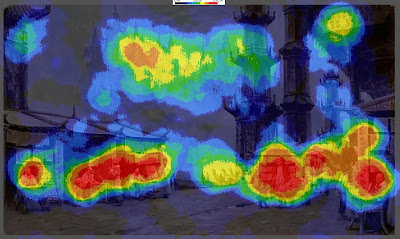 Here’s the heatmap for the painting Marketplace of Ideas, which we discussed in the last two posts.
Here’s the heatmap for the painting Marketplace of Ideas, which we discussed in the last two posts.
It turns out that there was very little interest in either of the main vertical columns. Instead, the red splotches reveal a concentration of interest in the figures. There were secondary interest areas in the far buildings and the sign in the upper right.
The interest in people, especially faces, appears to reflect a hardwired instinct to understand our fellow humans.  In the heatmap for Chasing Shadows, which shows a group of children running along a beach with a Brachiosaurus, there’s a strong focal point around the dinosaur's front feet and the nearby running children.
In the heatmap for Chasing Shadows, which shows a group of children running along a beach with a Brachiosaurus, there’s a strong focal point around the dinosaur's front feet and the nearby running children.
There are secondary points of interest at the dinosaur’s head and the leading child. Note how the action of the walking pose was read without directly looking at the rear leg.
Other spots of interest congregate around the dinosaur’s tail, the base and the top of the tree, and the vanishing point along the beach.
Hardly anyone looked directly at the sky, the upper palm fronds, or the middle section of the palm trunk. But these areas were presumably perceived in the halo of peripheral vision around the center point of vision. Have a look at this painting, and be aware of where your eyes travel.
Have a look at this painting, and be aware of where your eyes travel.
The heatmap for the painting Camouflage (click to enlarge) shows that everyone noticed the dinosaur’s face. They also spotted the hidden man and the small pink dinosaur.
According to statistical data connected to timing, these three faces drew almost everyone’s attention within the first five seconds. The dinosaur's face was statistically the first thing most people looked at, followed quickly by the hiding man. Below is one subject's scanpath, with the black numbers counting off seconds. I was surprised that the two patches of lichen on the tree above the man scored near 100% attention. Evidently viewers noticed these strange shapes in their peripheral vision and checked them to make sure they weren’t important, or somehow a threat to the man. From a narrative standpoint, I suppose they were a bit of a red herring, distracting with no payoff.
I was surprised that the two patches of lichen on the tree above the man scored near 100% attention. Evidently viewers noticed these strange shapes in their peripheral vision and checked them to make sure they weren’t important, or somehow a threat to the man. From a narrative standpoint, I suppose they were a bit of a red herring, distracting with no payoff.
The sunken log and the detailed patch of leaves in the lower left drew 60% of the viewers, perhaps because those were likely places for other dangers to hide.
Just because an element has sharp detail or strong tonal contrasts, it doesn’t necessarily attract the eye. The dark branches behind the dinosaur’s head drew almost no attention because they fit into the natural schema of a forest scene. Apparently the viewers developed a search strategy based on the threatening situation of a hungry dinosaur looking for a bite to eat.
PRELIMINARY CONCLUSIONS
These experiments force us to question a few of our cherished notions about composition and picture-gazing.
1. The eye does not flow in smooth curves or circles, nor does it follow contours. It leaps from one point of interest to another. Curving lines or other devices may be "felt" in some way peripherally, but the eye doesn't move along them.
2. Placing an element on a golden section grid line doesn’t automatically attract attention. If an attention-getting element such as a face is placed in the scene, it will gather attention wherever you place it.
3. Two people don’t scan the same picture along the same route. But they do behave according to an overall strategy that alternates between establishing context and studying detail.
4. The viewer is not a passive player continuously controlled by a composition. Each person confronts an image actively, driven by a combination of conscious and unconscious impulses, which are influenced, but not determined, by the design of the picture.
5. The unconscious impulses seem to include the establishment of hierarchies of interest based on normal expectations or schema of a scene. For example, highly contrasting patterns of foliage or branches will not directly draw the gaze unless they are perceived as anomalous in the peripheral vision.
5. As pictorial designers we shouldn’t think in abstract terms alone. Abstract design elements do play a role in influencing where viewers look in a picture, but in pictures that include people or animals or a suggestion of a story, the human and narrative elements are what direct our exploration of a picture.
As Dr. Edwards succinctly puts it, “abstract design gets trumped by human stories.” The job of the artist, then, in composing pictures about people is to use abstract tools to reinforce the viewer’s natural desire to seek out a face and a story.
--------------
Related previous posts on GurneyJourney:
Introduction to eyetracking, link.
How perception of faces is coded differently, link.
All the paintings are from Dinotopia: Journey to Chandara.
Many thanks to the team at Eyetools, Inc. for their assistance.
Blog: Gurney Journey (Login to Add to MyJacketFlap)
JacketFlap tags: Journey to Chandara, Illustrated Books, Add a tag
Dan Zimmer is best known for the beautifully produced ILLUSTRATION magazine, which is about the history of American Illustration. He also publishes ILLO, a book-length spotlight on the contemporary illustration scene.
He has just released ILLO 2, which features interviews with Michael Cho, Nancy Stahl, and Zina Saunders. Somehow I got lucky and they included me, too.
It’s hard to convey how extensive the coverage is on each person without actually seeing the whole issue, so here's every page. Go to a newsstand and pick one up so that Mr. Zimmer can keep making future issues. There are a lot of other deserving illustrators that he still needs to cover.
ILLO main website, link.
Blog: Gurney Journey (Login to Add to MyJacketFlap)
JacketFlap tags: Paint Technique, Journey to Chandara, Add a tag
This is Part 6 in the ongoing progress report on the Utopiales poster. The first steps of an oil painting are really important, because they set up opportunities for later stages of the rendering. When I paint an imaginary scene in oil, I usually try for three strategies in the first statement:
When I paint an imaginary scene in oil, I usually try for three strategies in the first statement:
1.Establish the overall color temperature for each region of the picture.
2. Suggest the large tonal statement of light and dark.
3. Keep everything a little lighter than the final rendering will be.
Following strategy #3 leaves you the option to achieve your final color rendering either transparently or opaquely. If you go too dark too soon, you can only correct it with opaques. Comparing the first step with the final below of Old Conductor from Journey to Chandara, the washin should look like the intended finish with a piece of tracing paper laid over it.The reason for #2 is that every judgment needs to be seen in context. If you paint each area starting from white, like paint-by-numbers, it’s harder to make accurate choices. It can be done, but to me it makes more sense for observational work.
The first strategy could be called a color imprimatura. A moonlight scene might be washed all over with a light blue-green. If the scene has different colored lights, each light region should be bathed in the color of each source. If there are multi-colored light sources, a white object will take on the relative color of each source.
------
Thanks to Online University Reviews for naming Gurney Journey one of the "100 Best Scholarly Art Blogs" (#65, right next to my buddy Tony DiTerlizzi.) Kudos to my assistant professor, my budgie!
------
Earlier post on "Area-by-Area" painting, link.
Blog: Gurney Journey (Login to Add to MyJacketFlap)
JacketFlap tags: Dinotopia, Journey to Chandara, Add a tag
The exhibition "Return to Dinotopia" opened on April 4 at the Centre for Life in Newcastle (UK).  Patrick Gyger, director of Maison d'Ailleurs, supervised the installation. Here’s how the room looked before the exhibition was fully in place.
Patrick Gyger, director of Maison d'Ailleurs, supervised the installation. Here’s how the room looked before the exhibition was fully in place. Jeanette and I are looking forward to visiting Newcastle-upon-Tyne this summer to see the museum and to visit some schools in the area.
Jeanette and I are looking forward to visiting Newcastle-upon-Tyne this summer to see the museum and to visit some schools in the area.  The Dinotopia exhibition consists of about 50 original oil paintings from Dinotopia: Journey to Chandara (2007). The show will continue for the whole summer, after which it will travel to Nantes in France for the Utopiales festival.
The Dinotopia exhibition consists of about 50 original oil paintings from Dinotopia: Journey to Chandara (2007). The show will continue for the whole summer, after which it will travel to Nantes in France for the Utopiales festival.
If there are any other museums in Europe that might be interested in hosting the “Return to Dinotopia” in 2010 and beyond, please contact Patrick Gyger, link.
Centre for Life Dinotopia page, link.
Blog: Gurney Journey (Login to Add to MyJacketFlap)
JacketFlap tags: Journey to Chandara, Add a tag

Dinotopia: l'ile aux dinosaures
A quoi ressemble Ie parfait recit imaginaire? A Dinotopia. Imaginez une ile aux paysages epoustouflants ou humains et dinosaures vivent en harmonie, une ville d'architecture classique construite a flanc de falaise, bordee de cascadesgeantes qu'enjambent des ponts sculptes. Sous un vol de pterosaures, des enfants partent a I'ecole dans un bus Apatosaurus et croisent un Brachiosaurus pompier… Ala maniere d'un Francois Place qui revisitait Ie recit d'exploration avec ses Derniers Giants, James Gurney embarque Ie lecteur encore plus loin dans Ie fantastique. Sous forme de camet de voyage, ses deux heros, Arthur Denison et son fils Will, content leur expedition a Chandara, un ancien empire interdit. Ils y rencontrent des merveilles de la civilisation dinotopienne mais aussi des Tyrannosaures qui ont envahi les basses terres ... Suivez l'etrange caravane, composee de porteurs de blasons et de triceratops. Partez pour un voyage au bout de l'utopie. II etait temps que I'on redecouvre en France cette serie fantastique traduite en dix-huit langues et creee il y a une dizaine d'annees par cet ancien illustrateur du National Geographic. Gurney propose mieux qu'une cartographie de I'imaginaire. Un monde qui fera rever bien des generations. NathalieRiche (Lire)
**Dinotopia. Un voyage a Chandara par James Gurney, traduit de I'americain par Juliette Saumande, 160 p., Fleurus
Blog: Gurney Journey (Login to Add to MyJacketFlap)
JacketFlap tags: Journey to Chandara, Add a tag
The Association of Science Fiction and Fantasy Artists (ASFA) recently announced their 2007 awards, based on the vote of working artist members. Donato Giancola was the big winner, with five awards, including best hardback and paperback cover. Michael Kaluta won in the Artistic Achievement category, and Irene Gallo was chosen as the best Art Director (see her art/illustration blog here). If you will pardon me for tooting my own horn, Dinotopia: Journey to Chandara was chosen in the Best Interior Illustration category. I am very grateful to the members of ASFA for their vote of support.
If you will pardon me for tooting my own horn, Dinotopia: Journey to Chandara was chosen in the Best Interior Illustration category. I am very grateful to the members of ASFA for their vote of support.
If you're still looking for that last special holiday gift for that artistic someone, you can get Gurney-signed copies of the Chandara book or the Chesley Award Retrospective from the Dinotopia Store. If you send in your check today (USA only) you should get the book in plenty of time for Christmas. End pitch.
Blog: Gurney Journey (Login to Add to MyJacketFlap)
JacketFlap tags: Dinosaurs, Journey to Chandara, Preliminary Sketches, Add a tag
What? An Arthur Denison action figure? And isn’t that Nallab the librarian all beefed up and ready for adventure? Back in 1995 when Dinotopia was in development for a theatrical motion picture, the Hasbro toy company embarked on an ambitious proposal for a Dinotopia toy line. What you are looking at are one-of-a-kind presentation prototypes, not production toys.
Back in 1995 when Dinotopia was in development for a theatrical motion picture, the Hasbro toy company embarked on an ambitious proposal for a Dinotopia toy line. What you are looking at are one-of-a-kind presentation prototypes, not production toys.
Focus group tests at Hasbro showed that boys and girls liked Dinotopia equally and that kids spontaneously played with dinosaur toys by having people feeding the dinosaurs and riding them, not just the “attack mode” that has become so commonplace. Hasbro took the unprecedented step of teaming up their boy and girl toy designers to generate ideas in what is normally a very gender-segregated and conceptually stereotyped category of merchandise. For my own part, starting as early as 1991, I did a number of sketches to explore how my characters might look if they were translated visually in other forms.
For my own part, starting as early as 1991, I did a number of sketches to explore how my characters might look if they were translated visually in other forms. Above are some character key drawings in gouache with an acetate overlay to see how they would look in line and flat color.
Above are some character key drawings in gouache with an acetate overlay to see how they would look in line and flat color.
The theatrical motion picture never came to pass, and neither did the toys, which is a common fate of concept proposals. In 1999, we decided to permit a TV miniseries to move forward instead, and we strictly limited the merchandising—but that’s another story.
On future posts, if you’re interested, I’ll share a few of the exploratory prototypes as well as some of my own unpublished development sketches.
---------
I’d like to express my thanks and appreciation to the talented team at Hasbro, as well as Michael Stone of The Beanstalk Group, plus Jim Black, Ken Ralston and Lynda Guber, together with Robert Gould of Imaginosis, who helped develop the film project.
Blog: Gurney Journey (Login to Add to MyJacketFlap)
JacketFlap tags: Journey to Chandara, Add a tag
The April issue of Ranger Rick magazine devotes eight pages to a portfolio from Dinotopia: Journey to Chandara, exploring how dinosaurs help humans and vice versa. There's also a page with an exclusive feature: "Where did the idea for Dinotopia come from, anyway?"
Ranger Rick is my favorite nature magazine, and this issue has plenty of other fun stuff, like advice on how to properly skip a stone, catch a frog, make a dandelion chain, and whistle with a blade of grass. Do any of those things, and you'll know that spring is here at last.
Blog: Gurney Journey (Login to Add to MyJacketFlap)
JacketFlap tags: Plein Air Painting, Journey to Chandara, Academic Painters, Golden Age Illustration, Lighting, Add a tag
Light coming through trees results in the spotted light we know as dappled light. The painting below is by Ivan Shishkin.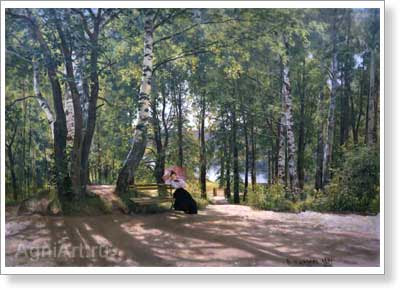
The circular spots of light shining on the ground vary in size depending on how high the canopy is above the ground. A high tree canopy leads to larger circles with softer edges. Below, in this early Albert Bierstadt painting called “Sunlight and Shadow” the effects of dappled light are worked out extremely convincingly.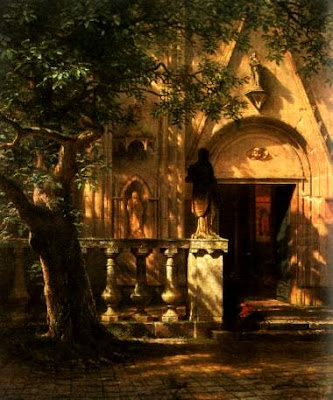
When bundles of light pass through small spaces between the leaves, each of those spaces act like a pinhole camera. The parcels of light are essentially like conical shapes of illumination radiating from each pinhole in the foliage.
The circles of light touching the ground are actually projections of the disk of the sun. In fact on days with a partial eclipse of the sun, the circles of light will appear as half circles. In the 8x10 inch oil study above, the circles of light on the roof of the shed are about a foot in diameter.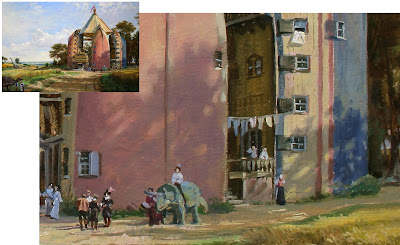 When each cone of light intersects a sloping surface like a wall, it results in an elliptical shape. On a vertical surface parallel to the picture plane, the long axis of that ellipse will always angle back toward the source of the light.
When each cone of light intersects a sloping surface like a wall, it results in an elliptical shape. On a vertical surface parallel to the picture plane, the long axis of that ellipse will always angle back toward the source of the light.
In the detail above from Dinotopia: Journey to Chandara, the light is coming from the right. The circles become ellipses as the form of the ship's red hull curves away on the left side.Therefore, ellipses of light projected on a wall in front of us will slope upward to the right only if the sun is also coming from the right, as it is in this photo also.
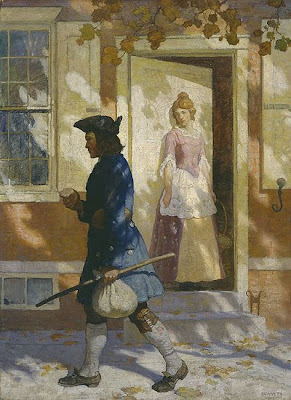 Apparently N.C. Wyeth was unaware of this principle when he designed this otherwise fine illustration of Ben Franklin’s arrival in Philadelphia. The result is an error in lighting. According to the cast shadows from Franklin’s leg and from the tree branch at the bottom of the picture, the light is coming from above and to the right. But the ellipses of light on the wall point impossibly to a light source above and to the left.
Apparently N.C. Wyeth was unaware of this principle when he designed this otherwise fine illustration of Ben Franklin’s arrival in Philadelphia. The result is an error in lighting. According to the cast shadows from Franklin’s leg and from the tree branch at the bottom of the picture, the light is coming from above and to the right. But the ellipses of light on the wall point impossibly to a light source above and to the left.
Further discussion of dappled light, with photographic examples, on Edward Tufte's website, link.
Blog: Gurney Journey (Login to Add to MyJacketFlap)
JacketFlap tags: Journey to Chandara, Journey to Chandara, Add a tag
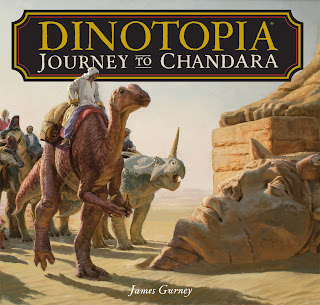 Because an incoming snowstorm is expected to dump over a foot of snow between here and Massachusetts tonight and tomorrow, the March 1 Dinotopia booksigning event at the Odyssey Bookshop in South Hadley, MA has been cancelled and now rescheduled for Saturday, April 26 at 11:00 a.m.
Because an incoming snowstorm is expected to dump over a foot of snow between here and Massachusetts tonight and tomorrow, the March 1 Dinotopia booksigning event at the Odyssey Bookshop in South Hadley, MA has been cancelled and now rescheduled for Saturday, April 26 at 11:00 a.m.
Blog: Gurney Journey (Login to Add to MyJacketFlap)
JacketFlap tags: Journey to Chandara, Journey to Chandara, Add a tag
If you ever need to invent a bronze sculpture for a fantasy or science fiction painting, here are a couple of little tips to make the weathered surface more convincing. I painted this oil study from observation to study how actual bronze surfaces weather. Note how the upfacing planes of the hat brim, the lapel, and the forehead are all oxidized to a light blue-green color.
I painted this oil study from observation to study how actual bronze surfaces weather. Note how the upfacing planes of the hat brim, the lapel, and the forehead are all oxidized to a light blue-green color.
The hollows and the downfacing planes weather in a different way as this photo shows. Instead of being entirely covered with a light blue-green oxidation, the downward planes tend to be darker and browner. This is because the downfacing planes are exposed to less rainwater. The top of the ball is also shielded from rain, and lacks oxidation. Wherever the planes face downward, the water is forced to flow in fixed rivulets. Each rivulet then becomes a line of oxidation.
You can play with this effect. This bronze head from the title page of Dinotopia: Journey to Chandara was entirely invented. Along the cheeks the rivulets almost look like the path of tears.
If the statue is in a public area, projecting forms are often buffed to a golden sheen from contact with the hands (or hides) of passersby.
As the rainwater drains off the statue, the dissolved oxides leave stains on the white marble below.
Blog: Gurney Journey (Login to Add to MyJacketFlap)
JacketFlap tags: Journey to Chandara, Journey to Chandara, Add a tag
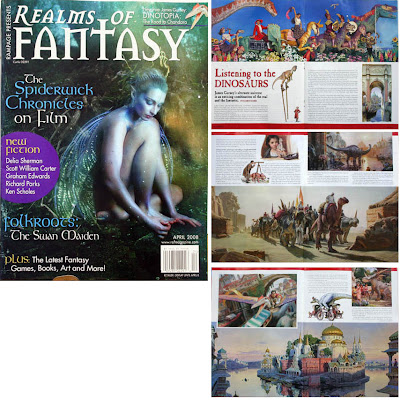 Realms of Fantasy magazine will have a six-page gallery feature on Dinotopia: Journey to Chandara, with an article by Karen Haber coming up in its April 2008 issue. It should hit the newsstands in a couple of weeks.
Realms of Fantasy magazine will have a six-page gallery feature on Dinotopia: Journey to Chandara, with an article by Karen Haber coming up in its April 2008 issue. It should hit the newsstands in a couple of weeks.
The issue also has an interview with Holly Black of Spiderwick, and fiction by Delia Sherman, Ken Scholes, Richard Parks, Graham Edwards, and Scott William Carter.
Blog: OUPblog (Login to Add to MyJacketFlap)
JacketFlap tags: Literature, Education, Blogs, alice, discussion, A-Featured, Prose, rule, douglass, adams, trial, meaning, Add a tag
 I’m going to digress for a moment but I promise it will all come around to Alice’s Adventures in Wonderland.
I’m going to digress for a moment but I promise it will all come around to Alice’s Adventures in Wonderland.
In The Hitchhiker’s Guide to the Galaxy (another great cult classic like Alice) the answer to “the great question… of Life, the Universe and Everything is…forty two.” The better question of course, is what the great question is. The great computer Deep Thought says, “So once you know what the question actually is, you’ll know what the answer means.” (more…)



Speaking of dinosaurs in China, have you seen this?
Dino Color
HAHA! 'grats to you being famous in China Mr Gurney! In mandarin, we say Chinese New Year to ppl through this 4 words: Gong Xi Fa Cai!
"Terrible dragons" indeed.